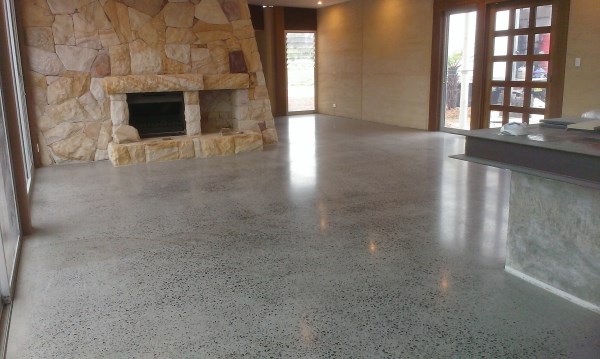For every type of polished concrete there are sublte differences on what is required to achieve a polished finish. Have a look at our Buyers Guide to Polished Concrete here.
The main three finishes where this is important is for a cream polish (aka burnished concrete), partial aggregate exposure (aka hit n miss or salt n pepper) or full aggregate exposure.
For Cream Polish or Burnished Concrete the following special requirements apply for concrete surfaces;
CASTING
For the floor to have a uniform appearance, the casting is of the greatest importance. (A poorly cast floor will be costly to grind, and even if the function of a polished floor can be achieved, the finish will be affected by uneven aggregate, cracks, etc.) The appearance of the finish is totally dependent on the concrete's appearance. Colour differences in the surface are to be expected. It is important to protect the slab during the building process from spills and staining as these cannot be removed.

1. The surface should be power floated. (To achieve a surface as pore-free and level as possible, thorough power
floating is required).
2. The surface should be heavily trowelled to obtain as smooth, dense and hard a surface as possible.
3. Normally, the concrete surface should be water hardened under plastic sheeting for 5-7 days after casting, before it
is time to start grinding.
4. The surface must not be waterlogged when impregnating. (This is to enable the sodium silicate impregnation to
penetrate and react with the concrete.)
Important Note: You cannot change the colour of the slab. The higher the finish of polish the lighter the slab will be in colour, however:
* hydration marks;
* cold joints;
* most chatter marks;
* footprints and consequent low spots left by them;
* blowout holes from carpet smooth edge fixings.
and any rough grainy finishes ESPECIALLY around the edges, internal corners and open doorways of slabs where the concreter’s helicopters cannot get to, and NO specialist care is taken to finish with hand tools to the same standard as the rest of the slab, CANNOT be rectified by polishing and will come out a completely different finish/colour to the rest of the slab.
Partial aggregate exposure aka Hit n Miss or Salt n Pepper
CASTING
For the floor to have a uniform appearance, the casting is of the greatest importance. (A poorly cast floor will be costly to
grind, and even if the function of a polished floor can be achieved, the finish will be affected by uneven aggregate, cracks,
etc.)
1. The surface should be power floated. (To achieve a surface as pore-free and level as possible, thorough powerfloating is required).
2. The surface should be power trowelled.
3. Normally, the concrete surface should be water hardened under plastic sheeting for 5-7 days after casting, before it
is time to start grinding. Grinding and honing can be carried out at this time while polishing is left until a later
date, when the moisture level in the concrete is lower.
4. The surface must not be waterlogged when impregnating. (This is to enable the sodium silicate impregnation to
penetrate and react with the concrete.)
The more the concrete surface is worked the further down the aggregate will be pushed. It is important that the floor is level as this will affect the amount of stone that is exposed.
Full aggrgate exposure
CASTING
For the floor to have a uniform appearance, the casting is of the greatest importance. (A poorly cast floor will be costly to
grind, and even if the function of a polished floor can be achieved, the finish will be affected by uneven aggregate, cracks,
etc.) It is important that special care is taken to minimise contamination of the concrete such as dirt/building products being walked in or cigarette butts. All boot holes must be filled with fresh concrete and not just filled in with slurry as this will leave footprints in the surface which cannot be ground out. The screed should also never rest or be excessily pushed into the surface as this will also cause the aggregate to be pushed down and this cannot be fixed later.
1. The surface should be power floated. (To achieve a surface as pore-free and level as possible, thorough power
floating is required).
2. The surface should be power trowelled moderately. A hard trowelled surface is more difficult and time-consuming
to grind through.
3. Normally, the concrete surface should be water hardened under plastic sheeting for 5-7 days after casting, before it
is time to start grinding. Coarse grinding and honing can be carried out at this time while polishing is left until a
later date, when the moisture level in the concrete is lower.
4. The surface must not be waterlogged when impregnating. (This is to enable the sodium silicate impregnation to
penetrate and react with the concrete.)
Before any new polished concrete slab is cast we always invite the builder or concretor to contact us and discuss the requirements specific to that application











